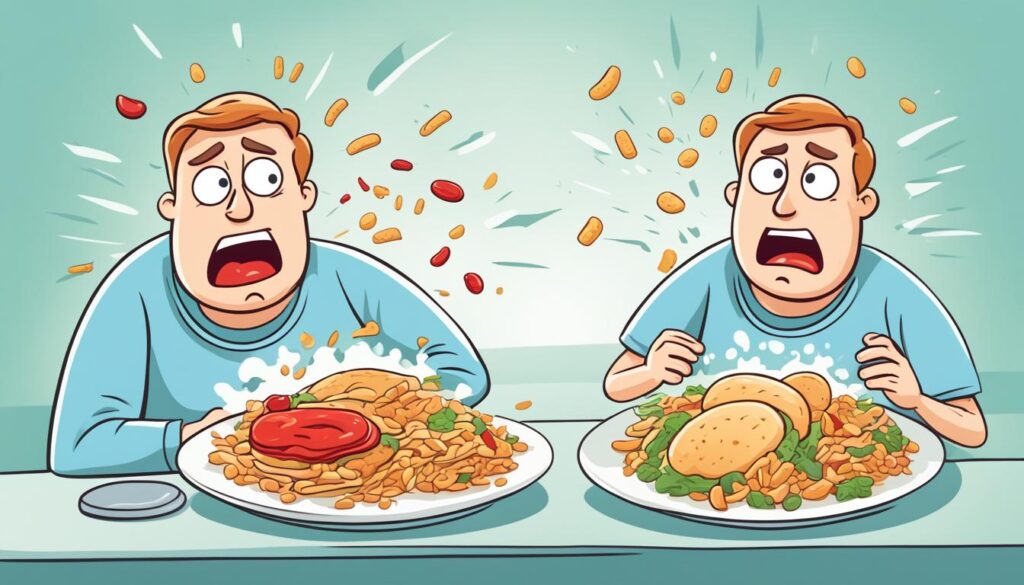Dumping syndrome happens when food moves too quickly from your stomach to the small intestine. This can happen after surgeries like gastric bypass or gastrectomy.
Table of Contents
ToggleSymptoms can be nausea, vomiting, abdominal cramps, diarrhea, dizziness, and a fast heart rate. Doctors usually diagnose it by listening to the patient’s symptoms. Then, they suggest managing it with dietary changes, medications, and sometimes more surgery.
Understanding Dumping Syndrome
Dumping syndrome means food moves too fast from stomach to small intestine. It’s often from stomach or esophageal surgery. This can happen years after the operation. Surgeries that change the stomach, like gastric bypass, can raise the risk. These operations are often for obesity, stomach cancer, esophageal cancer, and other issues.
Early vs. Late Dumping Syndrome
There are two types of dumping syndrome: early and late. Early happens in the first 30 minutes after you eat. Late starts 1 to 3 hours after a meal, often a high-sugar one. Some people feel it a bit later. They both share signs like nausea, vomiting, and stomach pain.

Symptoms of Dumping Syndrome
Early Dumping Syndrome Symptoms
There are early and late symptoms of dumping syndrome. Early symptoms happen 10 to 30 minutes after a meal. They include feeling bloated, nausea, vomiting, and diarrhea. You may also feel full, have cramps, flush, get dizzy, or have a fast heart rate.
Late Dumping Syndrome Symptoms
If you get late dumping syndrome, symptoms show up 1 to 3 hours after you eat. Your body may release too much insulin, causing low blood sugar. This can make you sweat, flush, feel dizzy, weak, or have a fast heart rate.
Some people have both early and late symptoms. It’s not fun, but it can happen.

What is Dumping Syndrome: Causes and Risk Factors
Dumping syndrome comes from food moving too fast from the stomach to the small intestine. This can happen because of changes in how the stomach works. These changes can be in the muscles of the stomach or the pyloric valve’s action. The pyloric valve controls the food flow from the stomach to the small intestine.
Stomach and Pyloric Valve
The stomach can have up to a gallon of food or liquid in it. It’s key in causing dumping syndrome after surgery. When the stomach and pyloric valve don’t work right, food leaves the stomach too quickly. This fast dumping of stomach contents is a big factor in dumping syndrome.
Surgeries Increasing Dumping Syndrome Risk
Surgeries that change the stomach can make dumping syndrome more likely. This includes gastric bypass and other stomach surgeries. They mess up how the stomach and pyloric valve should work, causing contents to empty too soon. Even years after surgery, dumping syndrome can still happen. It hits people in different ways, with some having early and late symptoms.
Managing and Treating Dumping Syndrome
The main ways to treat are through diet, medicines, and sometimes surgery. Changing what you eat is key. You should eat smaller meals more often and avoid sugary foods. Eat more protein, fiber, and fats. These steps work well for many people with the condition.
Dietary Changes
For those with , it’s best to have small meals often. Avoiding sugar helps too. Plus, adding more protein, fiber, and good fats helps slow down the stomach. This reduces the chance of quick food movement. Some find that resting for 30 minutes after eating helps with early symptoms.
Medications
Along with diet, might be needed. Doctors can prescribe drugs that slow down the stomach. These include alpha-glucosidase inhibitors, somatostatin analogs, and prokinetic agents. One of these, octreotide, often helps. It works well in the long and short term. But, drugs can cause side effects like nausea and diarrhea for some people.
Surgery
Surgery might be suggested for serious or long-term cases. It aims to fix the stomach to work better. There are different surgery options. Doctors might do stomal revision, Billroth II to Billroth I, or other procedures. These methods are for people who don’t improve with diet or meds.
Talk to your doctor about a plan to manage . Together, you can find what works for you to control this problem.
Conclusion
Dumping syndrome is a serious issue, but it can be managed with awareness. It happens when food moves too quickly from the stomach to the small intestine. This is often seen after stomach or esophageal surgery.
Symptoms like nausea, vomiting, and stomach cramps are common. You might also have diarrhea, feel dizzy, or have a fast heartbeat. This could happen a lot after specific types of stomach surgeries. But, there are ways to make it better. This includes changes in what you eat, medicines, or more surgery.
Your doctor can help you make a plan to deal with dumping syndrome. You may need to change what you eat, take slow-down medicines, or have more surgery. With good help and advice, you can manage this condition. You can live a better life.
FAQ
What is dumping syndrome?
What are the symptoms of dumping syndrome?
How is dumping syndrome diagnosed?
What are the different types of dumping syndrome?
What causes dumping syndrome?
What are the risk factors for developing dumping syndrome?
How is dumping syndrome treated?
Source Links
- https://www.mayoclinic.org/diseases-conditions/dumping-syndrome/symptoms-causes/syc-20371915
- https://www.niddk.nih.gov/health-information/digestive-diseases/dumping-syndrome/symptoms-causes
- https://www.mayoclinic.org/diseases-conditions/dumping-syndrome/diagnosis-treatment/drc-20371922
- https://www.ncbi.nlm.nih.gov/books/NBK470542/
- https://www.ncbi.nlm.nih.gov/pmc/articles/PMC5064250/


